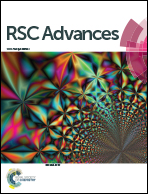Simultaneous degradation of tetracycline by a microbial fuel cell and its toxicity evaluation by zebrafish†
Abstract
Tetracycline (TC) is the second most commonly used antibiotic despite its high toxicity and persistence. In this study, a new approach for the anaerobic biodegradation of TC in a microbial fuel cell (MFC), with glucose–TC mixtures as the substrate, under gradient acclimation conditions was explored. Within 7 days, approximately 79.1% of TC was degraded by the MFC. This value was higher than that obtained through a traditional anaerobic method (14.9%). The TC degradation rates in MFCs with a closed circuit were 31.6% higher than those in MFCs with an open circuit. Furthermore, zebrafish assessment showed that no toxicity was observed after MFC treatment. Microbial community analysis was performed on the anode of the MFCs under gradient acclimation conditions, and the results showed that TC was effectively degraded by the synergy of fermentative bacteria, acid-producing bacteria and electrogenic bacteria. This work confirmed that the anaerobic biodegradation of TC by MFCs is a cost-effective and environmentally friendly method.



 Please wait while we load your content...
Please wait while we load your content...